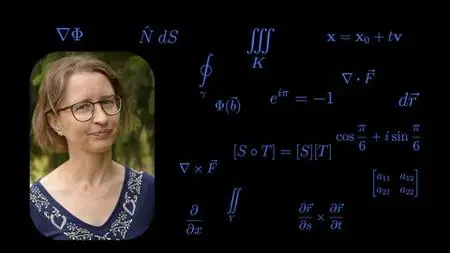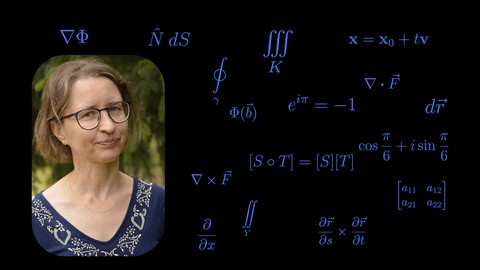Calculus 3 (multivariable calculus), part 2 of 2.
MP4 | Video: h264, 1280x720 | Audio: AAC, 44100 Hz
Language: English | Size: 30.4 GB | Duration: 44h 18m
MP4 | Video: h264, 1280x720 | Audio: AAC, 44100 Hz
Language: English | Size: 30.4 GB | Duration: 44h 18m
Towards and through the vector fields, part 2 of 2. Integrals and vector calculus.
What you'll learn
How to solve problems in multivariable calculus and vector calculus (illustrated with more than 150 solved problems) and why these methods work.
7 types of integrals: double, double improper, triple, line and surface integrals of functions and of vector fields.
Green's, Stokes' and Gauss' theorems.
Conservative vector fields and their potentials; fundamental theorem for conservative vector fields.
Gradient, curl and divergence.
Direct and inverse substitutions for multiple integrals with many examples; Fubini's theorem for various types of domains.
Surfaces as graphs of functions of two variables and parametric surfaces.
Five methods of computing line integrals of vector fields and four methods of computing surface integrals of vector fields (flux integrals).
Requirements
Calculus 1 and 2
Some linear algebra
Calculus 3, part 1 or an equivalent (curves, sets in the plane, functions of several variables with limits, continuity and differentiability, partial derivatives, and simple PDEs)
Description
Calculus 3 / Multivariable Calculus, Part 2 of 2
Towards and through the vector fields
(Chapter numbers in Robert A. Adams, Christopher Essex: Calculus, a complete course. 8th or 9th edition.)
C4 Multiple integrals (Chapter 14)
Introduction to the course; repetition (Riemann integrals, sets in the plane, curves)
Double integrals on APR (axis-parallel rectangles), x-simple and y-simple domains; iteration of double integrals (Fubini's theorem)
You will learn: compute double integrals by iteration of single integrals.
Change of variables in double integrals
You will learn: compute double integrals via variable substitution (mainly to polar coordinates).
Improper integrals.
You will learn: motivate if an improper integral is convergent or divergent; use the mean-value theorem for double integrals in order to compute the mean value for a two-variable function on a compact connected set.
Triple integrals; change of variables in triple integrals.
You will learn: compute triple integrals by Fubini's theorem or by variable substitution to spherical or cylindrical coordinates; compute the Jacobian for various kinds of change of variables.
Applications of multiple integrals such as mass, surface area, mass centre.
You will learn: apply multiple integrals for various aims.
C5 Vector fields (Chapter15)
Vector fields, conservative vector fields.
You will learn: about vector fields in the plane and in the space; conservative vector fields; use the necessary condition for a vector field to be conservative; compute potential functions for conservative vector fields.
Line integrals of functions and line integral of vector fields.
You will learn: calculate both kinds of line integrals and use them for computations of mass, arc length, work; three methods for computation of line integrals of vector fields.
Surfaces and surface integrals.
You will learn: understand surfaces described as graphs to two-variable functions f:R^2–>R and as parametric surfaces, being graphs of r:R^2–>R^3; determine whether a surface is closed and determine surfaces' boundary; determine normal vector to surfaces; calculate surface integrals of scalar functions and use them for computation of mass and area.
Oriented surfaces and flux integrals.
You will learn: determine orientation of a surface; determine normal vector field; choose orientation of a surface which agrees with orientation of the surface's boundary; calculate flux integrals and use them for computation of the flux of a vector field across a surface.
C6 Vector calculus (Chapter16: 16.1–16.5)
Gradient, divergence and curl and some identities involving them; irrotational and solenoidal vector fields (Ch. 16.1–2)
Green's theorem in the plane (Ch. 16.3)
Gauss' theorem (Divergence Theorem) in 3-space (Ch. 16.4)
Stokes' theorem (Ch. 16.5).
You will learn: define and compute curl and divergence of (two- and three-dimensional) vector fields and proof some basic formulas involving gradient, divergence and curl; apply Green's, Gauss's and Stokes's theorems, estimate when it is possible (and convenient) to apply these theorems.
Also make sure that you check with your professor what parts of the course you will need for your final exam. Such things vary from country to country, from university to university, and they can even vary from year to year at the same university.
A detailed description of the content of the course, with all the xxx videos and their titles, and with the texts of all the xxx problems solved during this course, is presented in the resource file "Outline_Calculus3_part2.pdf" under video 1 ("Introduction to the course"). This content is also presented in video 1.
Who this course is for:
University and college engineering



